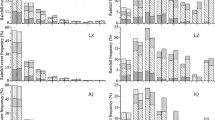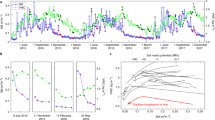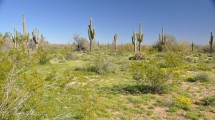Abstract
The ‘two-layer’ and ‘pulse-reserve’ hypotheses were developed 30 years ago and continue to serve as the standard for many experiments and modeling studies that examine relationships between primary productivity and rainfall variability in aridlands. The two-layer hypothesis considers two important plant functional types (FTs) and predicts that woody and herbaceous plants are able to co-exist in savannas because they utilize water from different soil layers (or depths). The pulse-reserve model addresses the response of individual plants to precipitation and predicts that there are ‘biologically important’ rain events that stimulate plant growth and reproduction. These pulses of precipitation may play a key role in long-term plant function and survival (as compared to seasonal or annual rainfall totals as per the two-layer model). In this paper, we re-evaluate these paradigms in terms of their generality, strengths, and limitations. We suggest that while seasonality and resource partitioning (key to the two-layer model) and biologically important precipitation events (key to the pulse-reserve model) are critical to understanding plant responses to precipitation in aridlands, both paradigms have significant limitations. Neither account for plasticity in rooting habits of woody plants, potential delayed responses of plants to rainfall, explicit precipitation thresholds, or vagaries in plant phenology. To address these limitations, we integrate the ideas of precipitation thresholds and plant delays, resource partitioning, and plant FT strategies into a simple ‘threshold-delay’ model. The model contains six basic parameters that capture the nonlinear nature of plant responses to pulse precipitation. We review the literature within the context of our threshold-delay model to: (i) develop testable hypotheses about how different plant FTs respond to pulses; (ii) identify weaknesses in the current state-of-knowledge; and (iii) suggest future research directions that will provide insight into how the timing, frequency, and magnitude of rainfall in deserts affect plants, plant communities, and ecosystems.




Similar content being viewed by others
References
Barnes CJ, Allison GB (1988) Tracing of water movement in the unsaturated zone using stable isotopes of hydrogen and oxygen. J Hydrol 100:143–176
BassiriRad H, Tremmel DC, Virginia RA, Reynolds JF, de Soyza AG, Brunell MH (1999) Short-term patterns in water and nitrogen acquisition by two desert shrubs following a simulated summer rain. Plant Ecol 145:27–36
Beatley J (1974) Phenological events and their environmental triggers in Mojave desert ecosystems. Ecology 55:856–863
Belsky AJ (1994) Influences of trees on savanna productivity: tests of shade, nutrients, and tree-grass competition. Ecology 75:922–932
Bowman DMJS, Minchin PR (1987) Environmental relationships of woody vegetation patterns in the Australian monsoon tropics. Aust J Bot 35:151–170
Breshears DD, Barnes FJ (1999) Interrelationships between plant functional types and soil moisture heterogeneity for semiarid landscapes within the grassland/forest continuum: a unified conceptual model. Landsc Ecol 14:465–478
Breshears DD, Myers OB, Johnson SR, Meyer CW, Martens SN (1997) Differential use of spatially heterogeneous soil moisture by two semiarid woody species: Pinus edulis and Juniperus monosperma. J Ecol 85:289–299
Briones O, Montana C, Ezcurra E (1996) Competition between three Chihuahuan desert species: Evidence from plant size-distance relations and root distribution. J Veg Sci 7:453–460
Briones O, Montana C, Ezcurra E (1998) Competition intensity as a function of resource availability in a semiarid ecosystem. Oecologia 116:365–372
Brisson J, Reynolds JF (1994) The effect of neighbors on root distribution in a creosotebush (Larrea tridentata) population. Ecology 75:1693–1702
Bristow KL, Campbell GS, Calissendorff C (1984) The effects of texture on the resistance to water movement within the rhizosphere. Soil Sci Soc Am J 48:266–270
Brown JR, Archer S (1990) Water relations of a perennial gass and seedling versus adult woody plants in a subtropical savanna Texas Usa. Oikos 57:366–374
Brown JR, Archer S (1999) Shrub invasion of grassland: Recruitment is continuous and not regulated by herbaceous biomass or density. Ecology 80:2385–2396
Brunel J-P, Walker GR, Kennett-Smith AK (1995) Field validation of isotopic procedures for determining sources of water used by plants in a semi-arid environment. J Hydrol 167:351–368
Burgess TL (1995) Desert grassland, mixed shrub savanna, shrub steppe, or semidesert scrub? In: McClaran MP, Van Devender TR (eds) The desert grassland. The University of Arizona Press, Tucson, pp 31–67
Cable DR (1969) Competition in the semidesert grass-shrub type as influenced by root systems, growth habits, and soil moisture extraction. Ecology 50:27–38
Campbell GS (1991) Simulation of water uptake by plant roots. In: Hanks J, Ritchie JT (eds) Modeling plant and soil systems. American Society of Agronomy, Madison, Wis., pp 273–285
Casper BB, Jackson RB (1997) Plant competition underground. Annu Rev Ecol Syst 28:545–570
Castellanos-Perez E (2000) Ecophysiological relationship of creosotebush (Larrea tridentata) and bush mully (Muhlenbergia porteri) when growing along and in common. New Mexico State University, Las Cruces, N.M.
Cohen D (1970) The expected efficiency of water utilization in plants under different competition and selection regimes. Isr J Bot 19:50–54
Dodd MB, Lauenroth WK, Welker JM (1998) Differential water resource use by herbaceous and woody plant life-forms in a shortgrass steppe community. Oecologia 117:504–512
Donovan LA, Ehleringer JR (1994) Water stress and use of summer precipitation in a Great Basin shrub community. Funct Ecol 8:289–297
Donovan LA, Grisé DJ, West JB, Pappert RA, Alder NN, Richards JH (1999) Predawn disequilibrium between plant and soil water potentials in two cold-desert shrubs. Oecologia 120:209–217
Donovan LA, Linton MJ, Richards JH (2001) Predawn plant water potential does not necessarily equilibrate with soil water potential under well-watered conditions. Oecologia 129:328–335
Dougherty RL, Lauenroth WK, Singh JS (1996) Response of a grassland cactus to frequency and size of rainfall events in a North American shortgrass steppe. J Ecol 84:177–183
Eagleson PS (2002) Ecohydrology. Darwinian expression of vegetation form and function. Cambridge University Press, Cambridge
Ehleringer JR, Dawson TE (1992) Water uptake by plants: perspectives from stable isotope composition. Plant Cell Environ 15:1073–1082
Ehleringer JR, Phillips SL, Schuster WSF, Sandquist DR (1991) Differential utilization of summer rains by desert plants. Oecologia 88:430–434
Ehleringer JR, Schwinning S, Gebauer RLE (1999) Water use in arid land ecosystems. In: Press MC (ed) Advances in plant physiological ecology. Blackwell Science, Oxford, pp 347–365
Epstein HE, Lauenroth WK, Burke IC, Coffin DP (1996) Ecological responses of dominant grasses along two climatic gradients in the Great Plains of the United States. J Veg Sci 7:777–788
Evans RD, Ehleringer JR (1994) Water and nitrogen dynamics in an arid woodland. Oecologia 99:233–242
Flanagan LB, Ehleringer JR, Marshall JD (1992) Differential uptake of summer precipitation among co-occurring trees and shrubs in a pinyon-juniper woodland. Plant Cell Environ 15:831–836
Forseth IN, Ehleringer JR, Werk KS, Cook CS (1984) Field water relations of Sonoran Desert annuals. Ecology 65:1436–1444
Freckman DW, Virginia RA (1989) Plant-feeding nematodes in deep-rooting desert ecosystems. Ecology 70:1665–1678
Gebauer RLE, Ehleringer JR (2000) Water and nitrogen uptake patterns following moisture pulses in a cold desert community. Ecology 81:1415–1424
Golluscio RA, Sala OE, Lauenroth WK (1998) Differential use of large summer rainfall events by shrubs and grasses: A manipulative experiment in the Patagonian steppe. Oecologia 115:17–25
Hacke UG, Sperry JS, Ewers BE, Ellsworth DS, Schäfer KVR, Oren R (2000) Influence of soil porosity on water use in Pinus taeda. Oecologia 124:495–505
Hellmers H, Horton JS, Juhren G, O’Keefe J (1955) Root systems of some chaparral plants in southern California. Ecology 36:667–678
Huenneke LF, Anderson JP, Remmenga M, Schlesinger WH (2002) Desertification alters patterns of aboveground net primary production in Chihuahuan ecosystems. Global Change Biol 8:247–264
Jackson RB, Canadell J, Ehleringer JR, Mooney HA, Sala OE, Schulze ED (1996) A global analysis of root distributions for terrestrial biomes. Oecologia 108:389–411
Jeltsch F, Milton SJ, Dean WRJ, Vanrooyen N (1996) Tree spacing and coexistence in semiarid savannas. J Ecol 84:583–595
Jeltsch F, Weber GE, Grimm V (2000) Ecological buffering mechanisms in savannas: a unifying theory of long-term tree-grass coexistence. Plant Ecol 150:161–171
Kemp PR, Reynolds JF, Pachepsky Y, Chen JL (1997) A comparative modeling study of soil water dynamics in a desert ecosystem. Water Resour Res 33:73–90
Kemp PR, Reynolds JF, Virginia RA, Whitford WG (2003) Decomposition of leaf and root litter of Chihuahuan desert shrubs: effects of three years of summer drought. J Arid Environ 53:21–39
Kieft TL, White CS, Loftin SR, Aguilar R, Craig JA, Skaar DA (1998) Temporal dynamics in soil carbon and nitrogen resources at a grassland-shrubland ecotone. Ecology 79:671–683
Knoop WT, Walker BH (1985) Interactions of woody and herbaceous vegetation in a southern African savanna. J Ecol 73:235–254
Kramer PJ, Bullock HC (1966) Seasonal variations in the proportion of suberized and unsuberized roots of trees in relation to the absorption of water. Am J Bot 53:200–204
Kutiel P, Kutiel H, Lavee H (2000) Vegetation response to possible scenarios of rainfall variations along a Mediterranean-extreme arid climatic transect. J Arid Environ 44:277–290
Lane DR, Collin DP, Lauenroth WK (1998) Effects of soil texture and precipitation on above-ground net primary productivity and vegetation structure across the Central Grassland region of the United States. J Veg Sci 9:239–250
Lauenroth WK, Sala OE, Milchunas DG, Lathrop RW (1987) Root dynamics of Bouteloua gracilis during short-term recovery from drought. Funct Ecol 1:117–124
Lauenroth WK, Urban DL, Coffin DP, Parton W, Shugart HH, Kirchner TB, Smith TM (1993) Modeling vegetation structure-ecosystem process interactions across sites and ecosystems. Ecol Model 67:49–80
Le Roux X, Bariac T, Mariotti A (1995) Spatial partitioning of the soil water resource between grass and shrub components in a West African humid savanna. Oecologia 104:147–155
Lee CA, Lauenroth WK (1994) Spatial distributions of grass and shrub root systems in the shortgrass steppe. Am Midl Nat 132:117–123
Lin G, Phillips SL, Ehleringer JR (1996) Monsoonal precipitation responses of shrubs in a cold desert community on the Colorado Plateau. Oecologia 106:8–17
Ludwig JA, Tongway D, Freudenberger D, Noble J, Hodgkinson K (1997) Landscape ecology: function and management. Principles from Australia’s rangelands. CSIRO, Collingwood, Australia
MacMahon JA, Wagner FH (1985) The Mojave, Sonoran, and Chihuahuan deserts of North America. In: Evenari M, Noy-Meir I, Goodall DW (eds) Hot deserts and arid shrublands. Ecosystems of the world. Elsevier, Amsterdam, pp 105–202
McAuliffe JR, McDonald EV (1995) A piedmont landscape in the eastern Mojave Desert: examples of linkages between biotic and physical components. San Bernardino Co Mus Assoc Q 42:53–63
McClaran MP, Van Devender TR (1995) The desert grassland. University of Arizona Press, Tucson
Midwood AJ, Boutton TW, Archer SR, Watts SE (1998) Water use by woody plants on contrasting soils in a savanna parkland: assessment with delta2H and delta18O. Plant Soil 205:13–24
Montaña C, Cavagnaro B, Briones O (1995) Soil water by co-existing shrubs and grasses in the Southern Chihuahuan Desert, Mexico. J Arid Environ 31:1–13
Moorhead DL, Reynolds JF, Fonteyn PJ (1989) Patterns of stratified soil water loss in a Chihuahuan Desert community. Soil Sci 148:244–249
Mordelet P, Menaut J-C, Mariotti A (1997) Tree and grass rooting patterns in an African humid savanna. J Veg Sci 8:65–70
Nobel PS, Zhang HH (1997) Photosynthetic responses of three codominant species from the north-western Sonoran Desert—a C3 deciduous sub-shrub, a C4 deciduous bunchgrass, and a CAM evergreen leaf succulent. Aust J Plant Physiol 24:787–796
Noy-Meir I (1973) Desert ecosystems: environment and producers. Annu Rev Ecol Syst 4:25–51
Noy-Meir I (1985) Desert ecosystems: structure and function. In: Evenari M, Noy-Meir I, Goodall DW (eds) Ecosystems of the world. Elsevier, Amsterdam, pp 92–103
Oesterheld M, Loreti J, Semmartin M, Sala OE (2001) Inter-annual variation in primary production of a semi-arid grassland related to previous-year production. J Veg Sci 12:137–142
Ogle K, Wolpert RL, Reynolds JF (2004) Reconstructing plant root area and water uptake profiles. Ecology (in press)
Paruelo JM, Lauenroth WK (1995) Regional patterns of normalized difference vegetation index in North American shrublands and grasslands. Ecology 76:1888–1898
Paruelo JM, Lauenroth WK (1996) Relative abundance of plant functional types in grasslands and shrublands of North America. Ecol Appl 6:1212–1224
Paruelo JM, Lauenroth WK, Burke IC, Sala OE (1999) Grassland precipitation-use efficiency varies across a resource gradient. Ecosystems 2:64–68
Paruelo JM, Sala OE, Beltran AB (2000) Long-term dynamics of water and carbon in semi-arid ecosystems: a gradient analysis in the Patagonian steppe. Plant Ecol 150:133–143
Passioura JB (1988) Water transport in and to roots. Annu Rev Plant Physiol Plant Mol Biol 39:245–265
Peláez DV, Distel RA, Bóo RM, Elia OR, Mayor MD (1994) Water relations between shrubs and grasses in semi-arid Argentina. J Arid Environ 27:71–78
Plamboeck AH, Grip H, Nygren U (1999) A hydrological tracer study of water uptake depth in a Scots pine forest under two different water regimes. Oecologia 119:452–460
Pockman WT, Martinez-Vilalta J, Jackson RB (2000) The contribution of deep root functioning to whole-plant water relations and xylem transport in Juniperus ashei. Ecological Society of America Annual Meeting, Snowbird, Utah
Polis GA, Hurd SD, Jackson CT, Pinero FS (1997) El Niño effects on the dynamics and control of an island ecosystem in the Gulf of California. Ecology 78:1884–1897
Puigdefábregas J, Pugnaire FI (1999) Plant survival in arid environments. In: Pugnaire FI, Valladares F (eds) Handbook of functional plant ecology. Marcel Dekker, New York, USA, pp 381–405
Reynolds JF, Virginia RA, Kemp PR, de Soyza AG, Tremmel DC (1999) Impact of drought on desert shrubs: effects of seasonality and degree of resource island development. Ecol Monogr 69:69–106
Reynolds JF, Kemp PR, Tenhunen JD (2000) Effects of long-term rainfall variability on evapotranspiration and soil water distribution in the Chihuahuan Desert: a modeling analysis. Plant Ecol 150:145–159
Reynolds JF, Kemp PR, Ogle K, Fernandez RJ (2004) Modifying the ‘Pulse-Reserve’ paradigm for deserts of North America: precipitation pulses, soil water and plant responses. Oecologia (in press)
Roupsard O, Ferhi A, Granier A, Pallo F, Depommier D, Mallet B, Joly HI, Dreyer E (1999) Reverse phenology and dry-season water uptake by Faidherbia albida (Del.) A. Chev. in an agroforestry parkland of Sudanese west Africa. Funct Ecol 13:460–472
Ryel RJ, Caldwell MM, Yoder CK, Or D, Leffler AJ (2002) Hydraulic redistribution in a stand of Artemisia tridentata: evaluation of benefits to transpiration assessed with a simulation model. Oecologia 130:173–184
Sala OE, Lauenroth WK (1985) Root profiles and the ecological effect of light rainshowers in arid and semiarid regions. Am Midl Nat 114:406–408
Sala OE, Parton WJ, Joyce LA, Lauenroth WK (1988) Primary production of the central grassland region of the USA. Ecology 69:40–45
Schenk HJ, Jackson RB (2002) Rooting depths, lateral root spreads and below-ground/above-ground allometries of plants in water-limited ecosystems. J Ecol 90:480–494
Schlesinger WH, Fonteyn PJ, Marion GM (1987) Soil moisture content and plant transpiration in the Chihuahuan Desert of New Mexico. J Arid Environ 12:119–126
Scholes RJ, Archer SR (1997) Tree-grass interactions in savannas. Annu Rev Ecol Syst 28:517–544
Schwinning S, Sala OE (2004) Hierarchy of responses to resource pulses in arid and semi-arid ecosystems. Oecologia (in press)
Schwinning S, Davis K, Richardson L, Ehleringer JR (2002) Deuterium enriched irrigation indicates different forms of rain use in shrub/grass species of the Colorado Plateau. Oecologia 130:345–355
Schwinning S, Starr BI, Ehleringer JR (2003) Dominant cold desert plants do not partition warm season precipitation by event size. Oecologia 136:252–260
Singh JS, Milchunas DG, Lauenroth WK (1998) Soil water dynamics and vegetation patterns in a semiarid grassland. Plant Ecol 134:77–89
Sperry JS, Adler FR, Campbell GS, Comstock JP (1998) Limitation of plant water use by rhizosphere and xylem conductance: results from a model. Plant Cell Environ 21:347–359
Thames JL (1979) Tucson validation site report. US/IBP Desert Biome Research Memorandum 77–3. In: Final Progress Reports, Validation Studies. Utah State University, Logan, Utah, pp 43–92
Walker CD, Richardson SB (1991) The use of stable isotopes of water in characterising the source of water in vegetation. Chem Geol 94:145–158
Walter H (1971) Natural savannahs as a transition to the arid zone. In: Ecology of tropical and subtropical vegetation. Oliver & Boyd, Edinburgh, pp 238–265
Wan C, Sosebee RE, McMichael BL (1994) Hydraulic properties of shallow vs. deep lateral roots in a semiarid shrub, Gutierrezia sarothrae. Am Midl Nat 131:120–127
Weltzin JF, McPherson GR (1997) Spatial and temporal soil moisture resource partitioning by trees and grasses in a temperature savanna, Arizona, USA. Oecologia 112:156–164
Weltzin JF, McPherson GR (2000) Implications of precipitation redistribution for shifts in temperate savanna ecotones. Ecology 81:1902–1913
Williams DG, Ehleringer JR (2000) Intra- and interspecific variation for summer precipitation use in pinyon-juniper woodlands. Ecol Monogr 70:517–537
Wondzell SM, Cunningham GL, Bachelet D (1996) Relationships between landforms, geomorphic processes, and plant communities on a watershed in the northern Chihuahuan Desert. Landsc Ecol 11:351–362
Yoder CK, Nowak RS (1999) Soil moisture extraction by evergreen and drought-deciduous shrubs in the Mojave Desert during wet and dry years. J Arid Environ 42:81–96
Acknowledgements
Susanne Schwinning, Michael Loik, Travis Huxman, David Tissue and two anonymous reviewers provided helpful comments and suggestions on earlier drafts. This work was stimulated by the “Workshop on Resource Pulse Use in Arid Ecosystems” held at the University of Arizona, Tucson (2002). This research was supported by a NASA Earth System Science Fellowship (#NGT5–30355) to K.O. and by USDA Specific Cooperative Agreement #58–1270–3-070 and NSF-DEB-02–12123. This paper is a contribution to the Jornada Basin LTER.
Author information
Authors and Affiliations
Corresponding author
Rights and permissions
About this article
Cite this article
Ogle, K., Reynolds, J.F. Plant responses to precipitation in desert ecosystems: integrating functional types, pulses, thresholds, and delays. Oecologia 141, 282–294 (2004). https://doi.org/10.1007/s00442-004-1507-5
Received:
Accepted:
Published:
Issue Date:
DOI: https://doi.org/10.1007/s00442-004-1507-5




